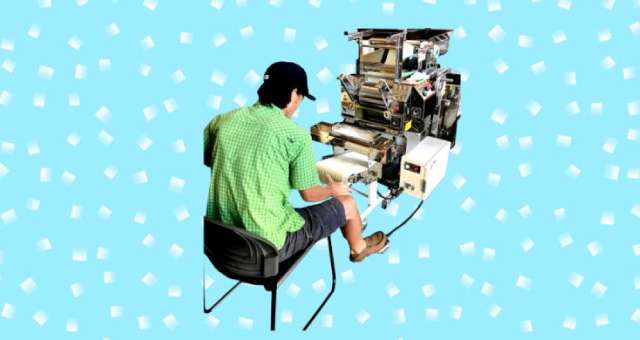Introduction
Are you curious about offset printing and want to learn more? Look no further! In this beginner’s guide, we will explore the world of offset printing, its advantages, and how it works. Whether you are an aspiring designer or simply interested in the printing industry, this guide will provide you with a solid foundation to understand the fundamentals of offset printing.
What is Offset Printing?
Offset printing is a popular and widely used printing technique that involves transferring ink from a plate to a rubber blanket, which then applies the ink to the desired printing surface. It is called “offset” because the ink is not directly applied to the paper or material being printed, but is offset onto another surface before being transferred.
How Does Offset Printing Work?
The offset printing process involves several steps:
Step 1: Prepress
In the prepress stage, the artwork or design is prepared for printing. This includes typesetting, layout, color separation, and preparing the printing plates.
Step 2: Plate Making
Once the design is finalized, the printing plates are made. These plates are usually made of aluminum and contain the images or text that will be printed.
Step 3: Ink Application
The ink is applied to the printing plates. The areas that are not meant to be printed are coated with a water-based solution to repel the ink.
Step 4: Transfer to Rubber Blanket
After the ink is applied to the plates, it is transferred to a rubber blanket. The rubber blanket allows for a more even and controlled transfer of ink.
Step 5: Offset onto Printing Surface
Once the ink is transferred to the rubber blanket, it is then offset onto the printing surface, which is usually paper or cardboard. The offset process ensures a high-quality print with sharp and clear images.
Step 6: Drying and Finishing
After the printing process, the printed materials are left to dry. Depending on the type of ink used, this may involve air drying or the use of drying equipment. Once dry, the materials are cut, folded, and finished according to the desired specifications.
Advantages of Offset Printing
Offset printing offers several advantages over other printing methods:
1. High-Quality Prints
Offset printing produces high-quality prints with sharp and vibrant colors. It can accurately reproduce images, gradients, and fine details, making it ideal for various printing projects.
2. Cost-Effective for Large Quantity Printing
Offset printing is cost-effective for large quantity printing. The more copies you print, the lower the cost per unit becomes. This makes it suitable for businesses and organizations that require bulk printing.
3. Versatility
Offset printing is versatile and can print on a wide range of materials, including paper, cardboard, fabric, and metal. It can be used for various applications such as brochures, flyers, business cards, labels, and packaging.
4. Consistent and Accurate Color Reproduction
Offset printing uses precise color matching systems, ensuring consistent and accurate color reproduction across multiple prints. This is crucial for maintaining brand identity and professional image.
Limitations of Offset Printing
While offset printing has numerous advantages, it also has some limitations:
1. High Initial Setup Cost
The initial setup cost for offset printing can be high, especially for small print runs. This is due to the need for printing plates and the setup time required for each job. It is more cost-effective for larger print quantities.
2. Longer Turnaround Time
Offset printing usually has a longer turnaround time compared to digital printing
Summary
Understanding Offset Printing: A Beginner’s Guide is a comprehensive resource that aims to demystify the process of offset printing. This guide is suitable for beginners who have little to no prior knowledge of offset printing and are eager to learn. The blog post covers various aspects of offset printing, including its definition, benefits, and the step-by-step process involved.
This guide will introduce you to the key components of offset printing, such as plates, ink, and paper, and explain how they work together to produce high-quality printed materials. You will also gain insights into the advantages of offset printing, including its cost-effectiveness for large print runs, consistent color reproduction, and versatility in accommodating different print materials.
By the end of this beginner’s guide, you will have a clear understanding of offset printing and its significance in the printing industry. Whether you plan to pursue a career in graphic design, print production, or are simply interested in the technicaliti you can check here es of printing, this guide will equip you with valuable knowledge that will undoubtedly enhance your understanding of the offset printing process.
- Q: What is offset printing?
- A: Offset printing is a commonly used printing technique where ink is transferred from a metal plate to a rubber blanket, then to the printing surface.
- Q: How does offset printing work?
- A: Offset printing works on the principle that oil and water do not mix. The image to be printed is first transferred onto a plate, which is dampened by water, keeping the non-printing areas moist. Ink is then applied to the plate, adhering only to the image area. The inked image is transferred to a rubber blanket and then onto the printing surface.
- Q: What are the advantages of offset printing?
- A: Offset printing offers high-quality prints with sharp and clean images, consistent color reproduction, and the ability to print on a wide range of surfaces. It is cost-effective for large print runs and provides accurate color matching.
- Q: What types of materials can be printed using offset printing?
- A: Offset printing can be used to print on various materials such as paper, cardboard, metal, plastic, fabric, and even wood.
- Q: Is offset printing suitable for small print runs?
- A: Offset printing is more cost-effective for large print runs due to the initial setup involved in creating the plates. However, it can still be used for small print runs if the quality and consistency of the print are important.
- Q: What is the difference between offset printing and digital printing?
- A: Offset printing uses plates and a rubber blanket to transfer the image, while digital printing directly transfers the image onto the printing surface using electrostatic rollers or drums. Offset printing is better suited for large quantities, while digital printing is more suitable for short print runs and on-demand printing.


